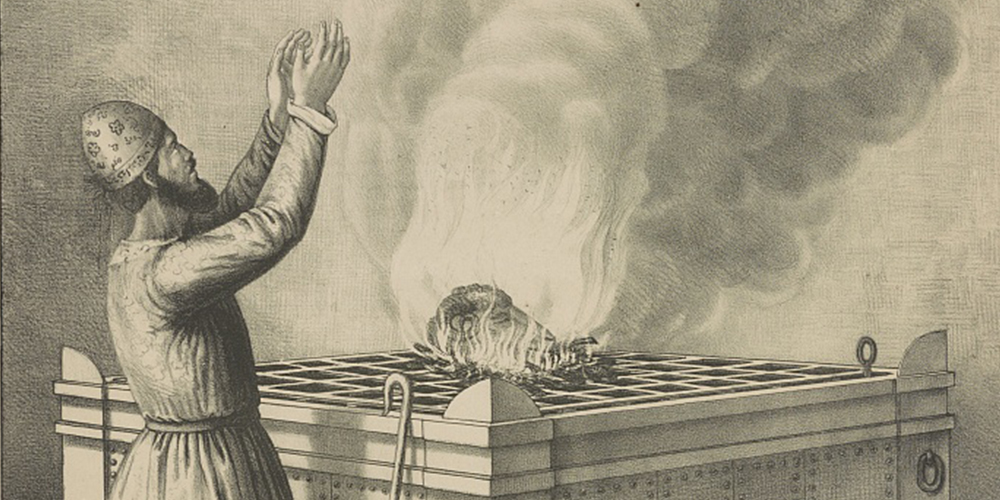The first offering mentioned is the burnt offering. The Hebrew word ‘ôlâh translated “burnt offering” means “to ascend.” The whole offering was to be completely burned up, with the ensuing smoke ascending to God as a sweet aroma. There had been burnt offerings earlier in Scripture (Gen. 4:4; 8:20; 22:2, 13), but now the procedure would be codified for the fledgling nation of Israel. God’s instructions primarily pertained to the offerer (Lev. 1) while additional instructions were given to the priests in Leviticus 6:8-13.
Voluntary Burnt Offerings (Lev. 1)
“When…” (v.2). A person could give a burnt offering at any time; it was a voluntary offering (“of his own free will,” v.3). Furthermore, there was no stipulated day or frequency. It was an act of worship and expressed devotion to the Lord. It was also substitutionary. Inherent in the sacrifice was a recognition that the offerer’s devotion was less than pure. It failed to attain to God’s standard, a standard that Christ Himself would later meet.
Opportunity for All
“…any one of you brings an offering to the LORD…” (v.2). Any man or woman could offer a burnt offering to express their love and appreciation for the Lord. The Lord accepted burnt offerings from all economic classes – the rich, the middle-class, and the poor according to their means. He provided instructions for offerings from the most to the least costly: a bull from the herd (vv.3-9); a sheep or goat from the flock (vv.10-13); or a turtledove or young pigeon (vv.14-17). A sacrifice from the herd pictured Christ as God’s chosen burden-bearing Servant (Isa. 53:4); one from the flock symbolized Christ as the silent, submissive, and sinless One (Isa. 53:7-8); while a dove portrayed Christ as the gentle and enduring One (Isa. 53:9, 11).1 All were domesticated creatures. Therefore, the offering cost the offerer something (2 Sam. 24:24); nothing wild was offered. In God’s redemptive plan, there was an infinite cost to both God and His Son (John 3:16; 1 Cor. 6:20; 1 Pet. 2:23-24).
Instructions for Voluntary Burnt Offerings
From the herd they were to offer a male without blemish which pictures the sinless, holy Son of God (Luke 1:35; 2 Cor. 5:21; 1 Pet. 2:22; 1 John 3:5). The offerer would present it before the Lord at the door of the tabernacle, near the brazen altar. Then he put his hand on the head of the burnt offering, identifying with the offering and acknowledging his acceptance. The value of the offering was imputed to the offerer. Ritchie notes, “The whole of its value became his own…It ceased that moment to be a question of what he was, and became a question of what his offering was.”2
MacKintosh writes, “By that significant act, the offerer and offering became one; and this oneness…secured for the offerer all the acceptableness of his offering.”3 Speaking of Christ and His Church, MacKintosh continues, “…it is not possible that the Head can be in one degree of acceptance and the members in another. No, the Head and the members are one.” 4 Christ’s perfect righteousness has been imputed to the believer (2 Cor. 5:21). Today the believer has an eternal identification with and acceptance in Christ. This is based upon God’s complete satisfaction with His Son (Phil. 2:5-11; 2 Pet. 1:17). We are “accepted in the Beloved” (Eph. 1:6).
The offerer then killed the sacrifice. This depicts that it was our sins that necessitated Christ’s death at Calvary. The priests, Aaron’s sons, captured the blood and sprinkled it all around the altar (v.5). Then the offerer skinned the animal and cut it into pieces (v.6). This revealed the hidden parts of the animal. This illustrates that both Christ’s inner and outer life were devoted to His Father. The priest received the skin which “he could sell or use for clothing or other practical purposes.”5 Today, the believer has new life in Christ, clothed with and identified with Him (Gal. 3:27). The priest put fire and wood on the altar (v.7) and then lay the parts, the head, and the fat in an orderly way on the wood (v.8). Then the offerer washed the innards and legs with water, removing any excrement and dirt. All parts of Christ’s life were without blemish. There was “the presentation to God of that which was infinitely acceptable Him.”6 After the priest placed these on the altar, the whole offering was burned as a sacrifice to the Lord (v.9).
The instructions for an offering from the flock were the same (vv.10-13) but described in less detail, though additional information is given that animals were slain on the north side of the altar (v.11). Both from the herd and flock, the male was the most valuable. This represents the matchless worth of Christ to His Father and the infinite value of His given life for our sins.
If the offerer presented a turtledove or young pigeon (vv.14-17), the priest brought it to the altar, wrung its head, drained out its blood beside the altar, and removed its crop (the enlarged part of the esophagus that temporarily stored food) and feathers throwing them on an ash heap to the east of the altar. The priest then split the bird at its wings, partially tearing it open before completely burning it upon the altar.
All three categories of burnt offerings end by saying it was “an offering made by fire, a sweet aroma to the LORD.” (vv.9,13,17). The burnt offering was an “offering made by fire.” This indicates that entirely burning the animal turned it into an offering. If all the steps above had been taken without burning the animal, the Lord would have taken no pleasure in it. The animal only became an offering when reduced to smoke.
The burning of this sacrifice “before the Lord” and the burning of the sin offering (flesh, skin, and dung) outside the camp (Ex. 29:14) were very different. Ritchie writes, “Here it is the holy altar-fire feeding on a victim well-pleasing to Jehovah; there it is the judgment-fire devouring a victim accursed because of sin…The word “burn,” used in connection with the burnt offering means “to burn as incense”…but the word used in connection with the sin offering means “to burn up or consume in a devouring fire…””7
Continual Burnt Offering (Lev. 6:8-13; Ex. 29:38-42)
Besides the voluntary burnt offering, there was also a burnt offering that was continual. The fire was to be kept burning, never to be extinguished or allowed to go out (vv.9,12,13). These “were the regular morning and evening sacrifices, rather than the burnt offerings brought by individuals…Doubtless, the principle that the offering should be utterly consumed without the fire going out would apply to any burnt offering.”8 The priest offered one lamb in the morning and another in the evening (Num. 28:3-4).
Before removing the ashes and placing them beside the altar, the priest was to put on his linen garments (v.10; Ex. 28:42-43). The ashes speak of Christ’s completed and accepted sacrifice. The linen garments symbolize His perfect righteousness. The ash heap “was on the east side of the altar, facing the gate, where the crop and feathers of birds were placed (1:16).”9 Then he took off his linen garments and put on other garments to carry the ashes outside the camp to a clean place (v.11).
Feast Days and Special Occasions
God also appointed burnt offerings for the weekly and annual feasts as well as for special occasions though the animals required varied. They were normally accompanied by the grain (meal) and drink offerings and occasionally sin offerings (Ex. 40:29; Num. 28–29; 1 Sam. 7:9-10; 2 Sam. 24:22-25).
Conclusion
The burnt offering was entirely for God. It typifies Christ fully pleasing His Father by voluntarily, solely, and completely giving Himself to God, even pouring Himself out unto death (Isa. 53:12; Eph. 5:2; Phil. 2:8; Heb. 9:14; 10:7-9). Our heavenly Father is delighted when we follow Christ’s selfless example (Rom. 12:1-2). It is a pleasing aroma to Him for it reminds Him of His Son. The Lord fully knows our hearts and values our sacrificial devotion to Him (Mark 12:41-44).
Endnotes:
1. Arthur E. Smith, Leviticus For Lambs (Kowloon, Hong Kong: Christian Book Room, 1998), p.24
2. John Ritchie, Tabernacle in the Wilderness (Grand Rapids, MI: Kregel Publications, 1982), p.41
3. C.H. MacKintosh, Notes on the Pentateuch (Neptune, NJ: Loizeaux Brothers, Inc., 1972), p.28
4. Ibid.
5. Unknown source
6. C.H. MacKintosh, p.287
7. John Ritchie, op. cit., p.43
8. What the Bible Teaches, Leviticus and Deuteronomy (Kilmarnock, Scotland: John Ritchie, 2010), p.84
9. Ibid.

